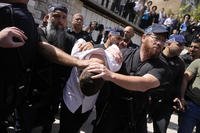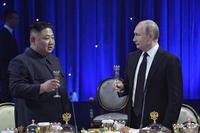PARIS -- Foreign militaries are in preliminary talks with DoD and its contractors over the possibility of buying the V-22 Osprey, defense and industry officials here said Wednesday. Although it's still so early in the discussions that neither the V-22's program manager nor a top official with Boeing would go into much detail, their hints at new international customers could mean the American tilt-rotor may begin serving in ever larger numbers around the world.
For the U.S. military, that would be no wonder. Marine Col Greg Masiello, the V-22's program manager, told reporters Wednesday that both the Corps and the Air Force love their versions of the V-22, which he said have redefined how troops can move and fight in the field. But not only that, Masiello made a case DoD probably hopes will appeal both to Washington and international audiences: The Osprey is a business success, as well as an operational one, and it not only deserves to be spared from the U.S. budgetary guillotine, foreign buyers might consider it even amidst austerity measures.
Masiello said the V-22 is the most cost-effective rotorcraft in DoD's inventory when measured by cost per passenger, and also its safest. Buzz readers already know about the Osprey's 100,000 flight hour milestone, but what Masiello said many people don't know is that half of those hours have been flown just in the past two years. He showed a chart comparing the costs of moving a Marine infantry company with Ospreys as opposed to "utility helicopters" -- he didn't identify which:
The Marines need four Ospreys to move all the troops and their gear, as compared with 16 helos; that means a cost of $296 million for the V-22s as compared to $488 million for the helos; the Osprey crew costs are $5 million, compared to $21 million; the Osprey doesn't need a forward refueling point or security, but the helos do, so the Marines factor a cost of $15 million; but the Ospreys' operation and sustainment rate is ".23," as compared to ".14." Bottom line: According to Masiello's chart, the Osprey costs $301.2 million, as compared to $524.1 million for the "utility helicopter." The conclusion: "Utility helicopter alternative is 74 percent more costly than V-22."
The chart did not give a time scale for those costs, but they're presumably over a fiscal year.
Jeff Kohler, vice president of business development for Boeing Military Aircraft, said the Osprey had to prove itself before it attracted the attention of other militaries. "A lot of countries wanted to wait and see how it performed," Kohler said, "It's been performing brilliantly."
Masiello said the most effective showcase for the Osprey has been in Afghanistan, where American allies have gotten a chance to see firsthand how the Marines and U.S. special operators have been using their aircraft. Although he did not say so, that suggests the interest in Ospreys is coming from NATO countries, possibly Great Britain, which has had a series of political dustups over British forces' lack of helicopters.
Kohler did acknowledge that discussions over international V-22 sales have matured to the point that, if potential customers ask about custom modifications for their own versions of the aircraft, Boeing is discussing the possibilities.








